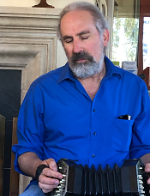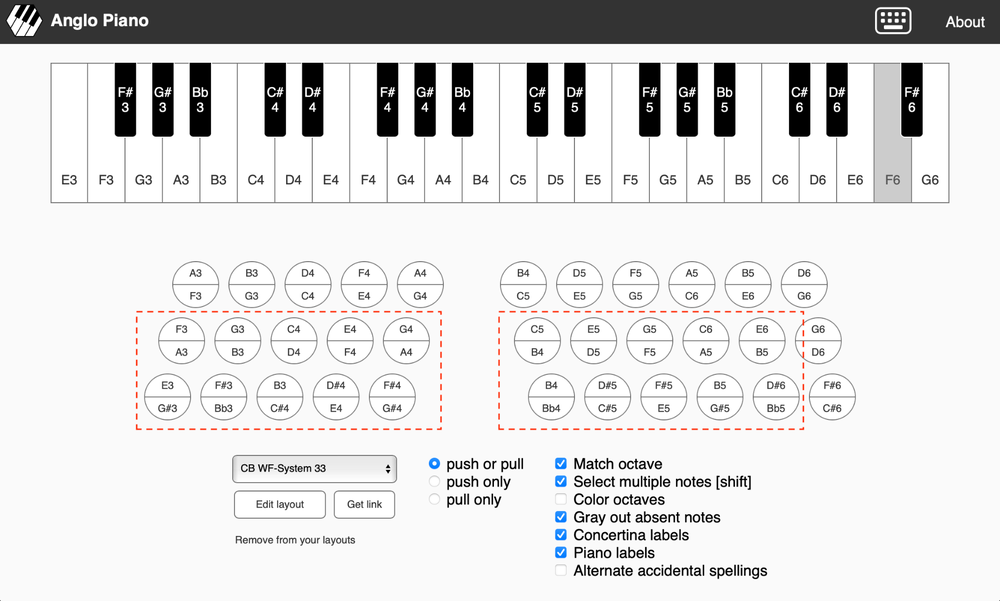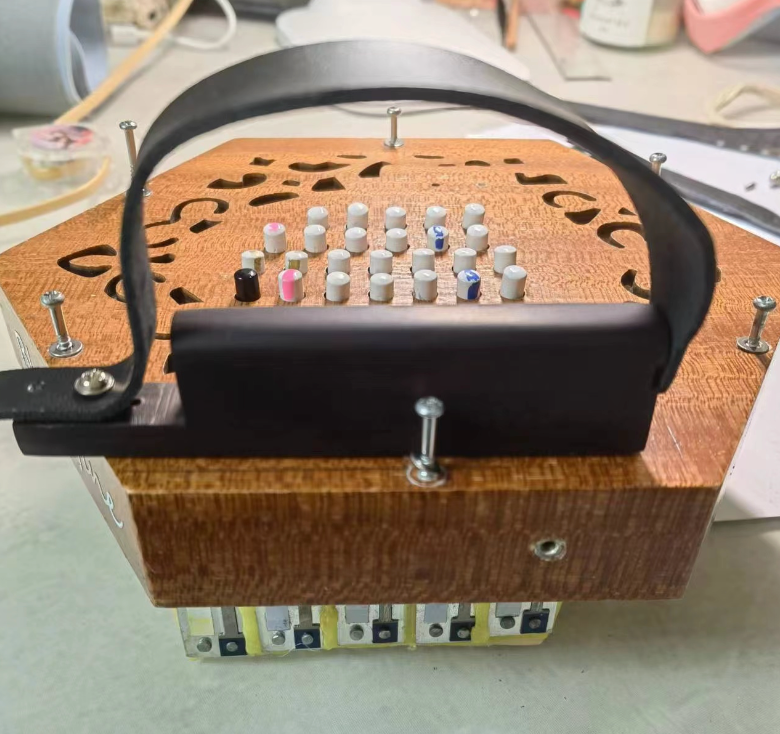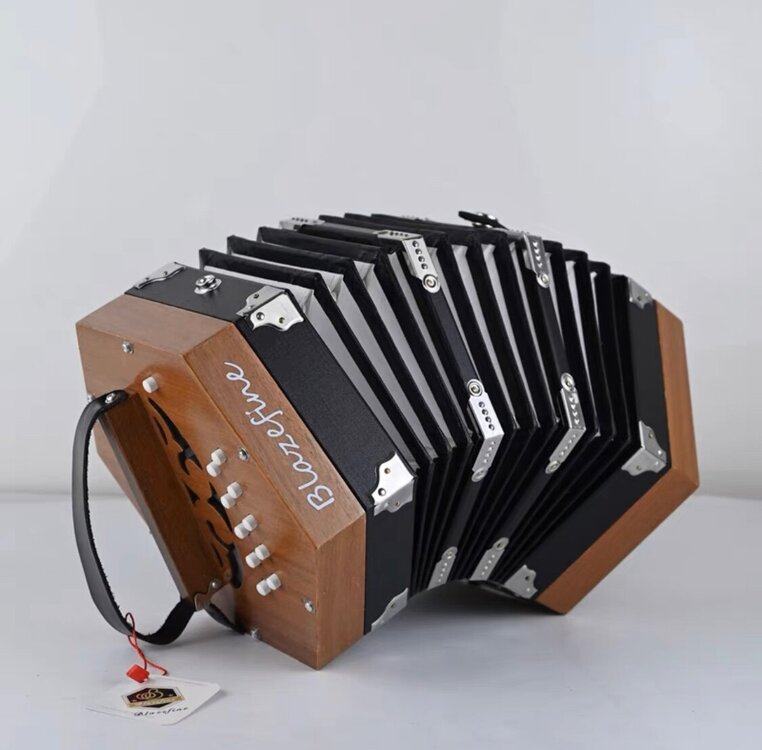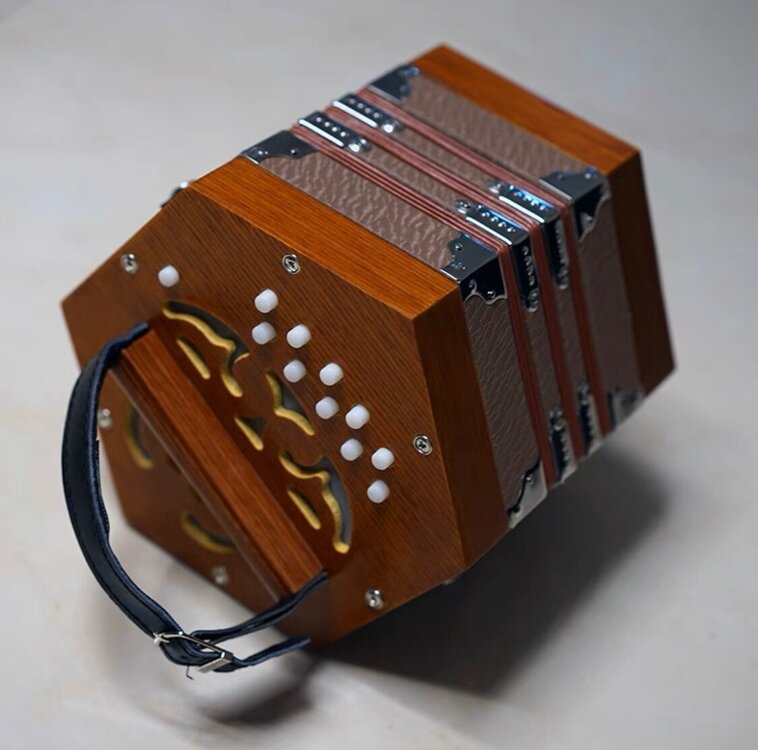-
Posts
58 -
Joined
-
Last visited
About Yuxin Ding
- Birthday April 14
Contact Methods
-
MSN
Not_sure_why_is_this_still_an_available_option@hotmail.com
Profile Information
-
Gender
Male
-
Interests
Anglo
-
Location
Jilin, China
Recent Profile Visitors
2,124 profile views
Yuxin Ding's Achievements

Advanced Member (3/6)
-

That's an interesting icon on your profile
Yuxin Ding replied to SIMON GABRIELOW's topic in General Concertina Discussion
I wish Gargamel didn't have an account here. -

Concertinas modified by Chinese
Yuxin Ding replied to Yuxin Ding's topic in General Concertina Discussion
Yang made a super long bellow with about 15 folds for his English-based "duet" concertina, to play sustained chords that last very long. Isn't the bellow reaches that length quite similar to some of the "real" duets? To be honest, I actually feel a little tangled to this kind of improvement, or should say renovation of the concertina, especially to who don't really can play or have a comprehensive understanding of the original instrument. However, for the situation in China, and maybe many countries in the world, this is probably the only option for some needs. And, any great design has to have a way to go! -
It's been almost two years since I started paying attention to concertinas. In the past two years I have met many people in China who are interested in the concertina through the Internet. I've noticed that among enthusiasts in this country, there seems to be an idea of reworking the instrument, not just adding or replacing a few notes, but an overhaul where they almost take the Anglo or English into Some kind of duet concertina. Here's the modification by Guoping Wang, an accordion maker from Beijing: The buttons within the red dashed box is his 20 buttons model. Buttons plan generated with Anglo Piano by Luke Hillman. I used to put this layout in this forum at here. And two modifications by Jun Yang, a music composer and professor from Wuhan, one is based on an English: Yang abandoned the air valve and made the button of it a note (C7.) He also rotated his concertina 90 degrees and installed hand rests and straps on it, to play it like an anglo or duets. (The hand rest was made by me, it was a spare for my Anglo.) His next overhaul will be based on an 40b Wheatstone/Lachenal layout Anglo, like this: Wang's layout is a bit like to split a two-row C/B melodeon to two ends, quite similar to a Franglo concertina, except his reversed row for 33b model. And Yang's layouts, according to him, are based on the piano keyboard and his major appeal of such a concertina is to accompanying other instruments. I've read and seen photos that concertinas were made many years ago with piano-like layouts, but I can't figure out why they didn't catch on like those systems are more popular. In some Chinese social media, I have seen more than once that someone has the idea of renovating the concertina. I personally agree with this idea a bit, because the various layouts of anglo are compromises for different needs to some extent, but similar improvements for English are not seems so necessary to me. (I don't play English, please point it out if I'm wrong about this.) However, such a large-scale renovation that completely overthrows the existing system makes me feel a little tangled. I think what Yang really needs is a baritone duet. But maybe he has no choice, because any kind of duet cannot be easily bought here in China.
-
My apology, I didn't see your post on the 2nd page until I made my post.
-
It appears that Hohner has indeed withdrawn from concertina. However, it wasn't until last year, when I was just starting to research concertinas, I noticed that an online music store in China still had D40s with Hohner's name on them, but now they've been removed from the list. I guess when Hohner canceled their last order, that manufacturer still had a lot of unfinished concertinas, especially the action boxes with the Hohner name on them, which are now all used up. The successor (maybe) of the D40 sold in China looks like this: Another online music store has a few original D40s in stock, but without a Hohner name on them: What Buttonpusher mentioned could be some of the last batches of D40s, otherwise he's just telling the experiment before Hohner withdrawn from the concertinas.
-
I assume there is one difference between the bows and bellows, that is the folds of bellows can be freely adding or reducing within an acceptable numbers, but the bows are usually come with fixed length(s), or should say the bows have to match the size of the instruments.
-

Cohen Braithwaite-Kilcoyne Anglo Tutor
Yuxin Ding replied to gcoover's topic in Teaching and Learning
Amazon international does ship goods to China but except for publications, because all the imported publications must go through 34 registered companies under China International Books Trading Corporation. However, it is fine to mail books to China personally, which is what I have been entrusting my friend to do for me. I think amazon.cn used to hold some imported books a couple of years ago (through the Books Trading Corp. of course) but they are now on the way to quitting the business and don't have any paperback books anymore. -

Cohen Braithwaite-Kilcoyne Anglo Tutor
Yuxin Ding replied to gcoover's topic in Teaching and Learning
I got my copy through a friend who lives in Japan, since the amazon don’t ship books to China (or China don’t allow amazon to?) It cost me US$50 with shipping from Japan included. I got the John Kirkpatrick book exactly the same way last year. Hoping there will be an easier and cheaper way to get Rollston Press books in China🥺 -
According to price quotes from many resources, vintage concertinas of equal quality, whether English or Anglo, asked for similar prices. Some of the Anglo were even more expensive than the English for those made in the late 19th and early 20th centuries, regardless of the one-of-a-kind special models. In the promotional materials at the time, the price of the Anglo was usually lower than that of the English. I was once told that the Anglo concertina was a working class instrument, so I wonder if the price of the Anglo today is due to the poor living conditions of Victorian and Pre-war British workers, caused many Anglos to be damaged or even destroyed, which raised the price of those survived or refurbished.
-

How to add a chord to this piece
Yuxin Ding replied to rainstormmmmmmmm's topic in General Concertina Discussion
The score is in Jianpu(literally means "Simple Score,") a kind of moveable-Do tablature. The numbers 1 to 7 in that meaning the tonic to the leading note of a major scale, or Do Re Mi to Ti. For this kind of tablature, you can't tell the key from notes, but it is defined at the beginning, and it also only shows tunes in major keys, for all the minor tunes, it just define as the related major. Back to the score in this thread, it's a Dm tune, and it defined as 1=F. Or should say "6=D," but that's not a standard. Jianpu is only used in China, Japan, and maybe Korea and Vietnam, and it almost only use for traditional musics and instruments. It also used for the basic level recording of other kinds of music nowadays. Jianpu can be considered a modernization of East Asian old tablature "Gongche." Here's a sample of Gongche, the tune is Shepherd's Hey: "工凡六工凡凡, 工凡六工尺, 工凡六工凡, 工凡六合上." You can read it here if you are interested. The Chinese traditional music usually focusing on the solo melodies more but not accompanying, that's why the Jianpu works here. But when the work goes complicated, its readability will goes down. I've seen someone use Jianpu to write some BWV works down, you can imagine how it looks like...... -

Why the duet concertina has more advantages but is not mainstream
Yuxin Ding replied to luli's topic in Teaching and Learning
I assume that I'm probably the friend that Luli talked about who "doesn't care the duets." Quite the contrary, it's not that I don't care about the duets. I just realized that any kind of duet is unlikely to be acquired easily, as Don Taylor said. In China, except for those entry-level concertinas sold directly by the workshops, any kind of concertina must be purchased from abroad. And also, for the duets, there are very limited tune books and tutorial materials that can get through the internet, unlike for anglos (appreciations to Gary Coover.) But I think maybe mastering duets, especially Hayden, because the button layout is more reasonable, so it doesn't require too many tutorials for someone with a certain musical background(?) Chinese makers mainly produce English and Anglo, and maybe the Elise that Don Taylor mentioned is also made in China, but as far as I know, no retailer has one of those. Concertina may be an unfamiliar instrument to the vast majority of the world, and even more so to the Chinese. I guess that there are only a few hundreds of people in China who own one and can basically play the concertina. There are seems slightly more anglo players in China than English players, but I haven't heard of anyone who can play or own a duet. -
Since all of Flying ducks concertinas are accordion reeds Hybrid with anglo fingering system, so they are still anglos to me. Although Ducklings and Dabblers are using wooden actions with a common pivot for a row of buttons, like German concertinas, but I think it's a unique design and actually shares more similarities with Stagi/Bastari style of action, only in wooden.
-
I wonder can the kind of 20 buttons concertina in this video be considered Anglo? I assume it's a German design based on Jones's Anglo (the hexagonal shape.) I've opened up and see the inside of one of this kind of concertina (Scholer,) and it has no reason to make it hexagonal except to make it looks like concertinas from England, which makes it a huge thing.
-

Left handed concertina?
Yuxin Ding replied to SIMON GABRIELOW's topic in General Concertina Discussion
This is indeed an impressive playing but I think it's more like just for fun, but not a efficacious scheme that benefit left-handers. The air button located pretty awkward in this way to me, and the thumb seems can do nothing. I've tried playing in this way somewhat badly before, but I'm probably not as smart as the guy in the video to get this done. Other than playing upside down, accordions or melodeons that are constructed to target left-handers from beginning seems to be rare, or even exist? As I found, they are either modified from ordinary box or unparalleled work up to very specific order, but still remains a lot of ordinary designs, or let's say for right hand users. I found something related in this thread on The Accordionist Forum. I'd also like to reiterate that for keys/buttons-pressing instruments, handedness is not as important as strings. Here's a good example: the free bass chromatic accordion, which has a wide variety of key layouts. The commonly used system of such instruments in Russia and east Europe is the B system (Bayan), and the commonly used in central and south Europe is called the C system (probably shorten from Chromatic), these two layouts are completely mirrored, moreover, some of them are the high notes on the both left and right ends that are close to the lap, and some are from low to high from left lap to right lap. All of these systems, layouts and combinations have tremendous players, on both quantity and their skills, and they just used to what they practiced since they started practice. I believe those who play the instrument upside down can do wonderful works, and maybe even achieve some unexpected special effects that ordinary way can't do. But since that's not what those designed for, it's still questionable to me whether it's an efficient way to play. -

Left handed concertina?
Yuxin Ding replied to SIMON GABRIELOW's topic in General Concertina Discussion
There are instruments designed for left-handed people like lefty guitar or bass, I think it is because these instruments require players do the different things on both hands, i.e., pressing or picking. I've played bass and violin, but I'm right-handed, and I'm guessing that string-picking and bow works require the player to use their dominant hand for those subtle manipulations. But for piano, keyboards and all the squeezeboxes, except pulling and pushing the bellow, all needed to do for both hands is just press the buttons or keys, and that makes the question "which hand is better for what" less necessary. Perhaps the accordions and melodeons are easier to play for lefties because they requires the player to operate the bellows with the left hand, and the dominant hand is usually stronger. And for those squeezeboxes that don't need to be hung on the body, like concertinas of course, bandoneons, etc, the bellow operating can be assigned to either hand at will, or switched at any time while playing.


